The Taxonomy of Spindles: Spindle Styles & Their Best Uses
In early 2000, I learned how to make yarn on a wheel through resources, support, and guidance offered by my local textile guild – the Langley Weavers and Spinners (British Columbia, Canada). A few years later, I learned how to spin on a top-whorl drop spindle and was instantly hooked. I embraced the simplicity and accessibility of the spindle. This launched my yarn-making and my foray into drop spindles. Fast forward a couple of dozen years to a global pandemic. Combine that with mind-craving stimulation and hands itching to learn a new series of skills, and I fell deep into the world of supported spindles.
When I first started learning how to make yarn with support spindles, I didn’t know what I was looking for in terms of beneficial features. I bought spindles that were beautifully crafted and gave me joy. That is until I started working with them. Over time, I’ve learned to appreciate the words of Stephanie Gaustad, “One spindle does not do it all, it does what it does again and again.” I challenged myself to understand what makes each spindle style unique and to figure out the extent to which I could get a wider range of yarns from the different spindle styles. As I gathered up my spindles and worked with each one, patterns began to emerge.

The Taxonomy of Spindles is the culmination of my research to date; an outline of how I’ve come to understand the workings of spindles, both historical and recent. My research not only helped me to categorize spindles, it gave me a deeper understanding of the importance of the various design elements.
Spindles are the simplest tools for making yarn. They are the vehicle for adding twist and the storage space for the newly made yarn. These elegant tools have played a fundamental role in the development of textile production throughout human history. Evidence of spindles and textile making exists across the globe and dates back thousands of years. The world of spindles covers a wide range of styles, materials, and spinning techniques adapted to cultural and regional traditions and fibre types. Spindle styles and spinning techniques developed in response to fibres available to be spun (short-stapled cotton or cashmere; long stapled northern wools, llamas, alpaca) and to the materials available for the spindle (wood, bone, clay, stone) within a region.
Spindle Categories
There are so many varieties and styles of spindles it can be overwhelming to try to understand it all, let alone choose one to spin with. To give an overview, we will categorize them based on the way we work with these amazing tools.
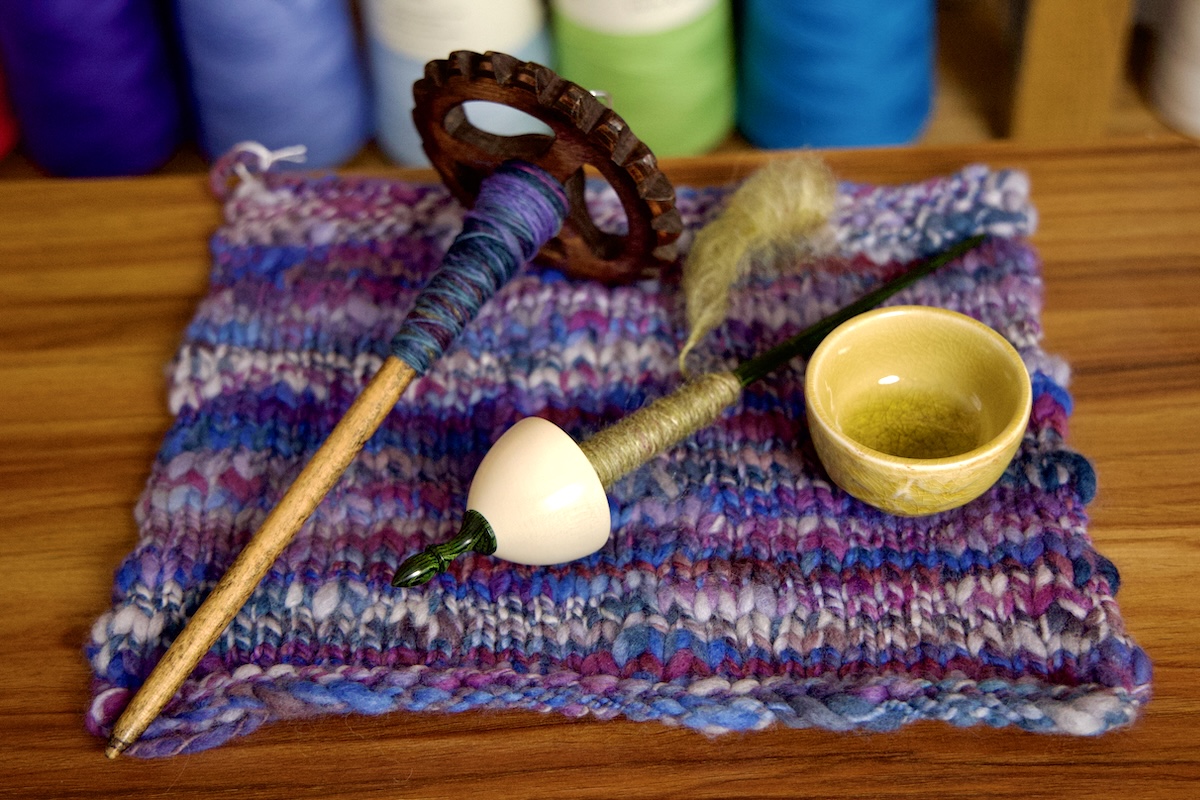
Generally, when we think of spindle spinning, we mostly work in two ways – suspending or supporting the spindles while they spin and providing the necessary twist for yarn formation. Because of this, spindles are described as coming from two large categories: suspended or drop spindles, where the yarn is made while the turning spindle hangs and supported spindles, where the yarn is made by twist entering the fibre supply and being pulled back, noting that the yarn does not bear the weight of the spindle as it sits supported in a bowl, on a lap, or on the ground. There is also another method which is referred to as the grasped spindle, which is a variation on a support spindle technique. Grasped spindles rest in the spinner’s hand and are twirled vertically, horizontally or at an angle depending on the tradition. They aren’t suspended because they don’t hang, and they are supported by the spinner’s hand, rather than a bowl, lap, or floor.
Within the two larger categories, there are several subcategories. This is the overall map of the taxonomy of spindles, as I understand it.
| Suspended or Drop Spindles | Supported Spindles |
|---|---|
| Top Whorl | Single Piece: *Phang / Goddess Russian Wand |
| Mid-Whorl | Separate Whorl: Stick & whorl Tibetan Navajo Tahkli |
| Bottom Whorl: Shaft & Disc Whorl / Peruvian Cross Piece / Turkish |
Modern Hybrids |
There are more spindle styles to add to this list, I have limited it to the styles of spindles that I have direct experience with and knowledge of. However, the larger categories are consistent with general knowledge about spindles. Let’s look at the spindles in the chart in greater detail.
Suspended Spindles
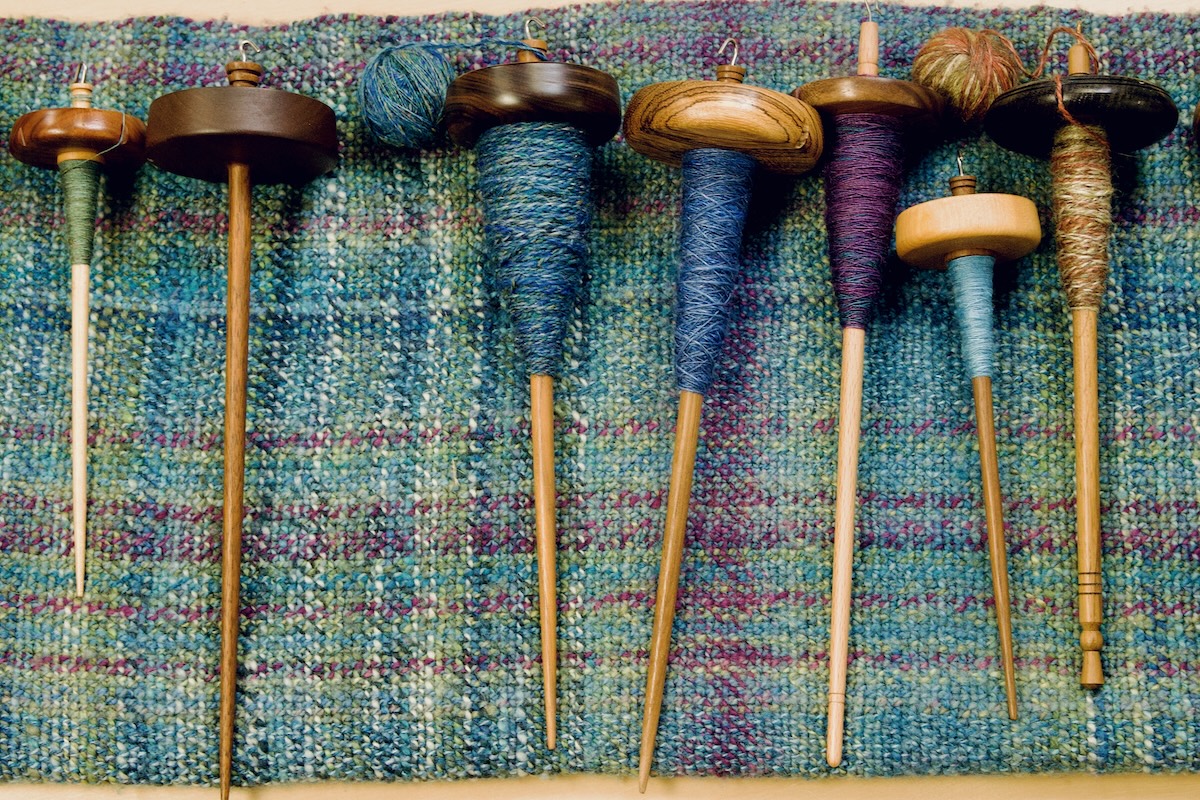
The Basic Anatomy of the Suspended Spindle
A suspended spindle consists of three main components: a shaft, a whorl, and a hook or notch.
- The Shaft is the smooth elongated portion of the spindle, mostly made of wood, and sometimes metal, plastic, and even bone. Some have decorative ridges along parts of the shaft, but most are smooth.
- The Whorl is a weight that is attached to the shaft and provides the momentum necessary for sustained spinning. Like the shaft, they are often made from wood but are also made from bone, antler, stone, clay, plastics, and metals. Whorls are often a disc or circular shape, except with the cross-piece (Turkish) style spindle. Whorls can be simple wooden discs or highly carved, figured with inlay and other decorations.
- The Hook (for the top whorl spindle) or Notch (for the bottom whorl spindle) secures the yarn during the spinning process.
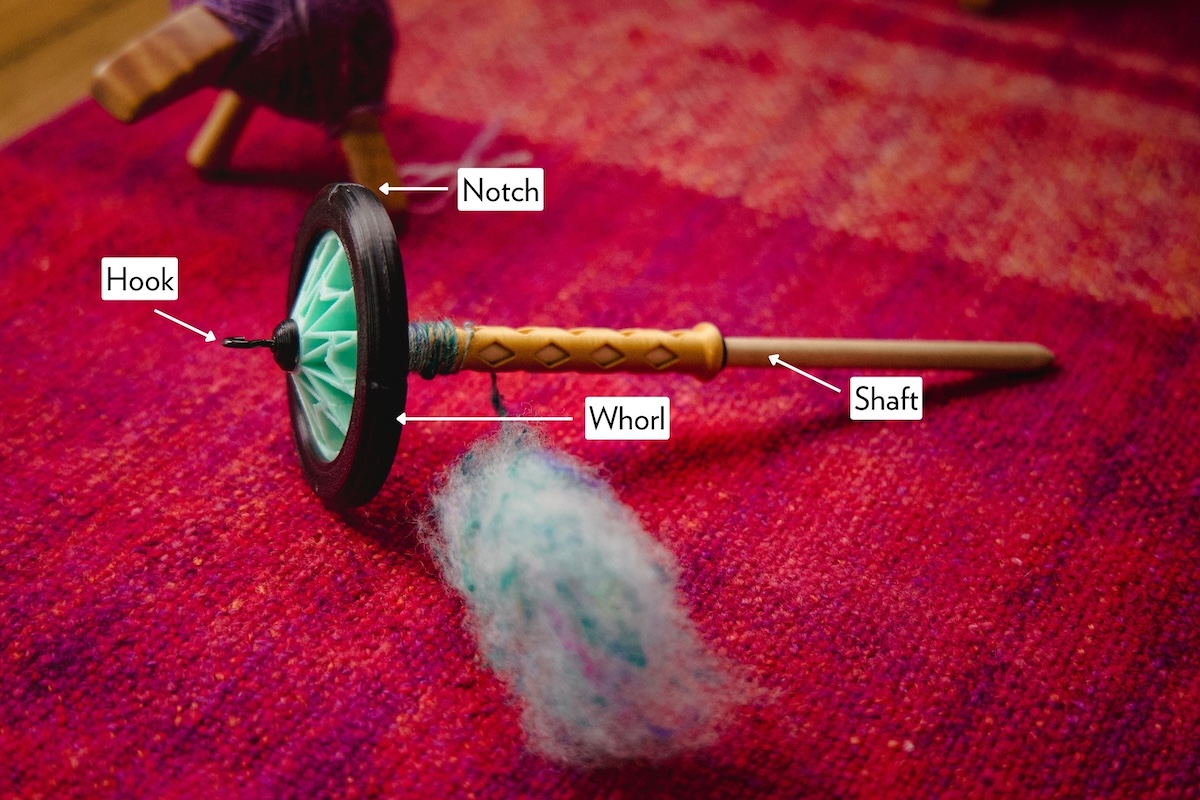
Suspended Spindle Styles
The location of the whorl on the suspended spindle leads to slight differences in spinning techniques, so it is a good way to categorize the styles.
- Top Whorl Spindles have the whorl located near the top of the shaft, with the bottom part of the shaft allowing for fast spinning by flicking the shaft with your finger or by rolling the shaft against the thigh if the size and shape of the cop allows.
- Mid-Whorl Spindles are sometimes used in the grasped spinning technique. The spindle is supported in the spinner’s hand while the yarn is formed, and once sufficiently formed, the spinner can then run the spindle against their thigh to add more twist (if necessary and/or desired). The yarn is stored above the whorl.
- Bottom Whorl Spindles:
- Disc Whorl / Peruvian Spindles have an exposed shaft that allows for a fast spin by a roll against the thigh or between the hands.
- Cross-Piece / Turkish Spindles have a cross-piece element on the spindle’s whorl, which allows for wrapping around the arms, which creates a centre-pull ball. The standard wrapping technique of “over two, under one” results in a cop that is higher on the top than the bottom, looking a bit like a turtle. Thus, the name turtle for a cop when using a cross-piece whorl.
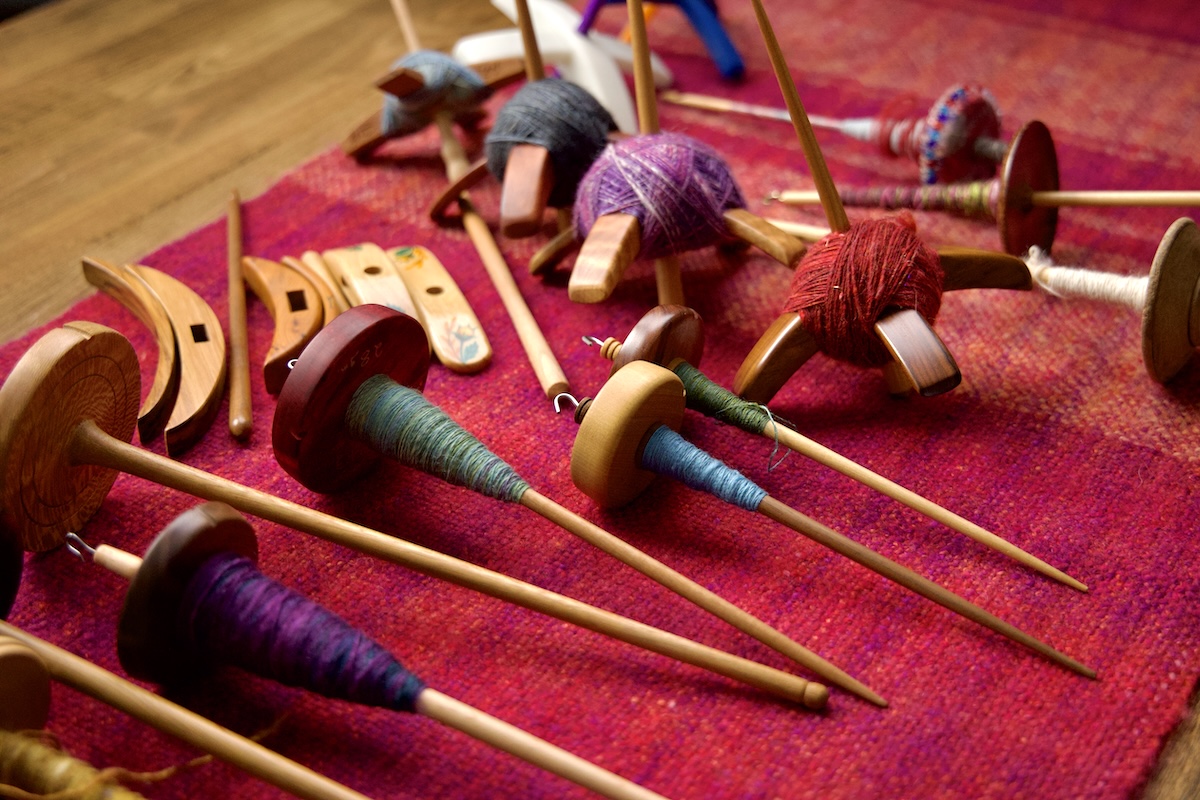
Suspended Spindle Considerations
Overall weight and length of the spindle
With this style of spindle, the yarn is made while the spindle (dangling and turning) adds twist to the fibre drafted out. The yarn being made must be able to support both the weight of the spindle and the growing cop. The lighter the spindle (14g – 20g), the greater the chance of spinning fine laceweight yarns. A heavier spindle (50+ grams), will comfortably produce thicker yarns. A lightweight spindle spins fast and long, lending itself to fine yarns that need a lot of twist. To make thick yarn with a lightweight spindle, you need to pay close attention to the spin, as the lightweight spindle will quickly reach its strength of spin and will start back spinning. The spin on a lightweight spindle can’t push the twist into thicker yarn. A heavier spindle has more momentum and can keep turning, putting as much twist into the yarn as you want. You can make thicker yarns with a lightweight spindle, but it will require you to pay attention to the drop in energy from the spin and respond quickly with more twist. A heavier-weight spindle is slow and steady in the spin and will help you make a thicker yarn.
The length of the spindle will add or take away from the overall weight of the spindle, and the length of the spindle also determines, to some extent, the size of the cop you can build.
Location and size of whorl notch
This is a feature on top whorl spindles. Once the yarn is wrapped around the cop on the shaft, it then travels up to the hook, where it is secured so you can continue spinning. To keep the yarn from sliding around the rim of the whorl, most top-whorl spindles have a notch or a groove carved into the outside edge of the whorl. A notch located right behind the hook makes for an easy transition from winding, notching, and securing the yarn on the hook.
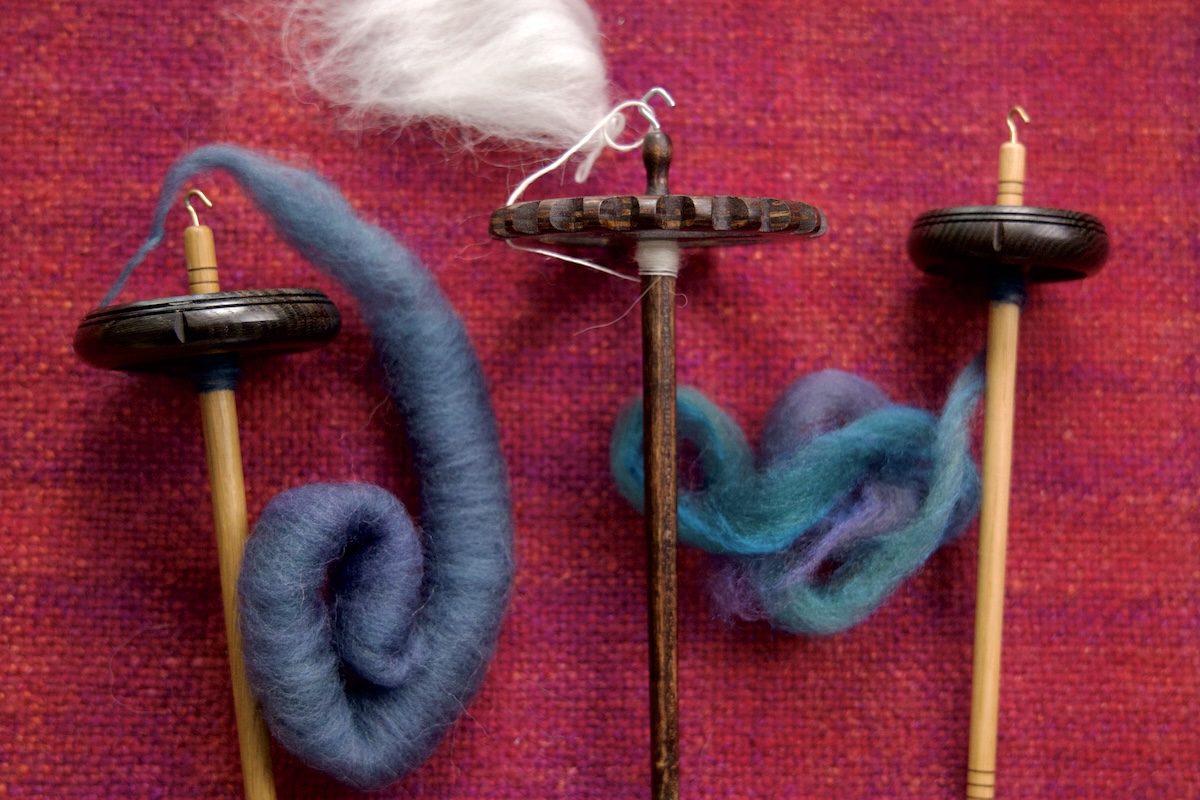
Shape of hook (if applicable)
Top and mid-whorl spindles have hooks at the top of the shaft. These hooks vary from the standard cup hook to a pigtail shape or other configurations. What you want to consider when evaluating a hook is the ease with which you can locate the hook to secure the yarn and the ease with which you can release the yarn from the hook.
In the world of suspended or drop spindles, there is a wide assortment of sizes, shapes, lengths, and weights to choose from. There are even top whorl spindles with removable bobbins attached to the spindle. Once the spindle is full, you remove the bobbin and replace it with a new one to carry on with your spinning.
Supported Spindles
The next large grouping of spindle styles is the supported spindle. Supported spindles are used to spin yarn while the spindle spins in a bowl or another support device. This style of spindle spinning encourages a long draw, where the twist enters the fibre supply, and the yarn is formed as the spinner pulls away from the twist. With this technique, the yarn being made doesn’t bear the weight of the spindle during spinning. The result is a fine, lofty yarn. A supported spindle is the spindle of choice when working with short-stapled fibres like cashmere, cotton, camel, and yak.

The Basic Anatomy of the Supported Spindle
A supported spindle consists of three (or four, depending on the spindle) main components: a flicking tip, a shaft, a spinning tip, and, in some instances, clear and distinct whorls.
- The Flicking Tip is the part of the spindle that you flick to get the twist going and the part of the spindle that the twist rolls off. Some spindles taper considerably at the flicking tip, allowing for a lot of twist with one flick. One of my favourite spindles doesn’t taper to a point. Instead, it ends with a gemstone, which to my surprise, does not interfere with my enjoyment or efficiency with the making yarn.
- Shaft Length (and Shape of the Shaft) will affect the shape of the cop you build. Keep in mind that you need to keep at least three inches free for flicking the spindle. If you have a shaft that tapers from thick to thin, you will have to wrap the cop so it doesn’t slide off the spindle. Some spindles (Phang/Goddess) have generous curves, like a waist, which are excellent spots to start building the cop.
- The Spinning Tip supports the rotation and can be made from wood, metal (titanium points or a ball bearing) and even blown glass.
- Whorl (if applicable) on supported spindles can be removable items or permanent parts of the spindle. They can be plain, or highly decorated. They provide weight at the bottom of the spindle and a shelf to build the cop against.
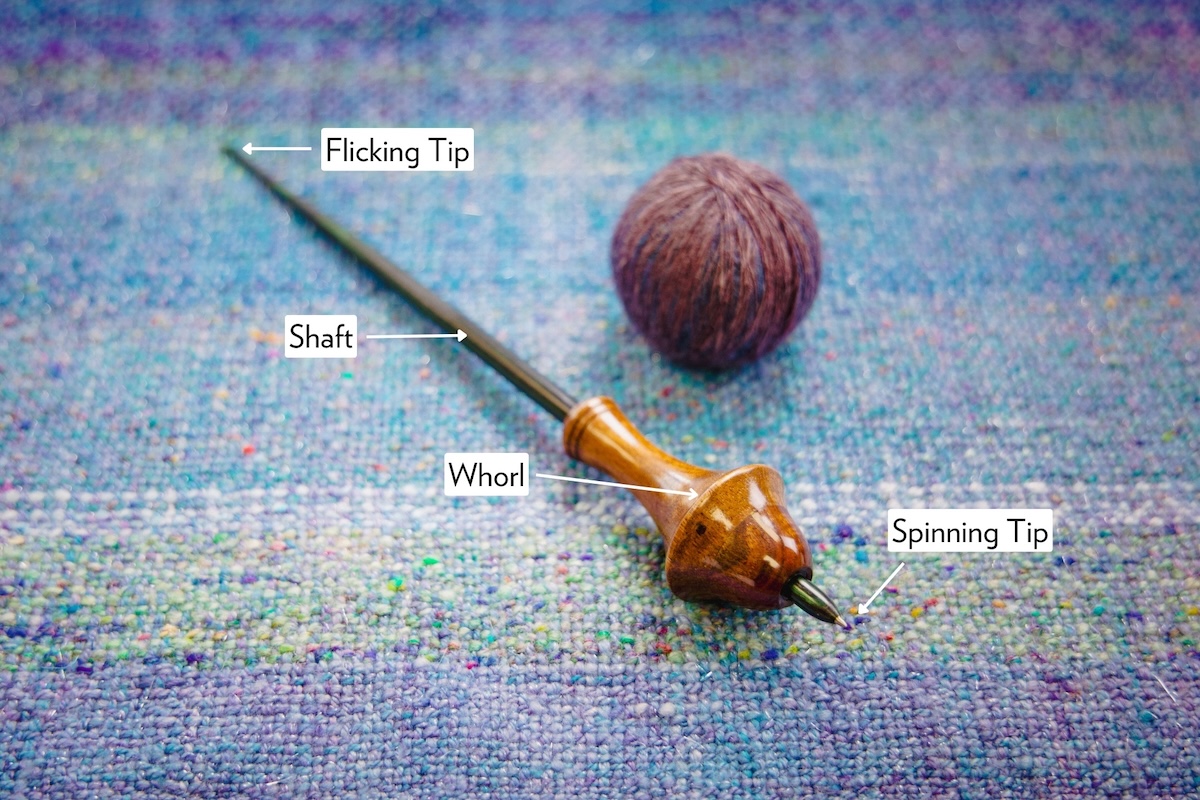
Supported Spindle Styles
- Single Piece Spindles found across the globe are carved from one piece of wood. Their different shapes support the spinning and storing of the spun yarn. Some examples are:
- Phang Spindles often have a curve in the middle, often described as a waist. The bottom half of these spindles is a bit thicker and slightly heavier than the top half.
- Russian Wand Spindles are known for having smooth long shafts and a slightly heavier bottom which serves as a whorl.
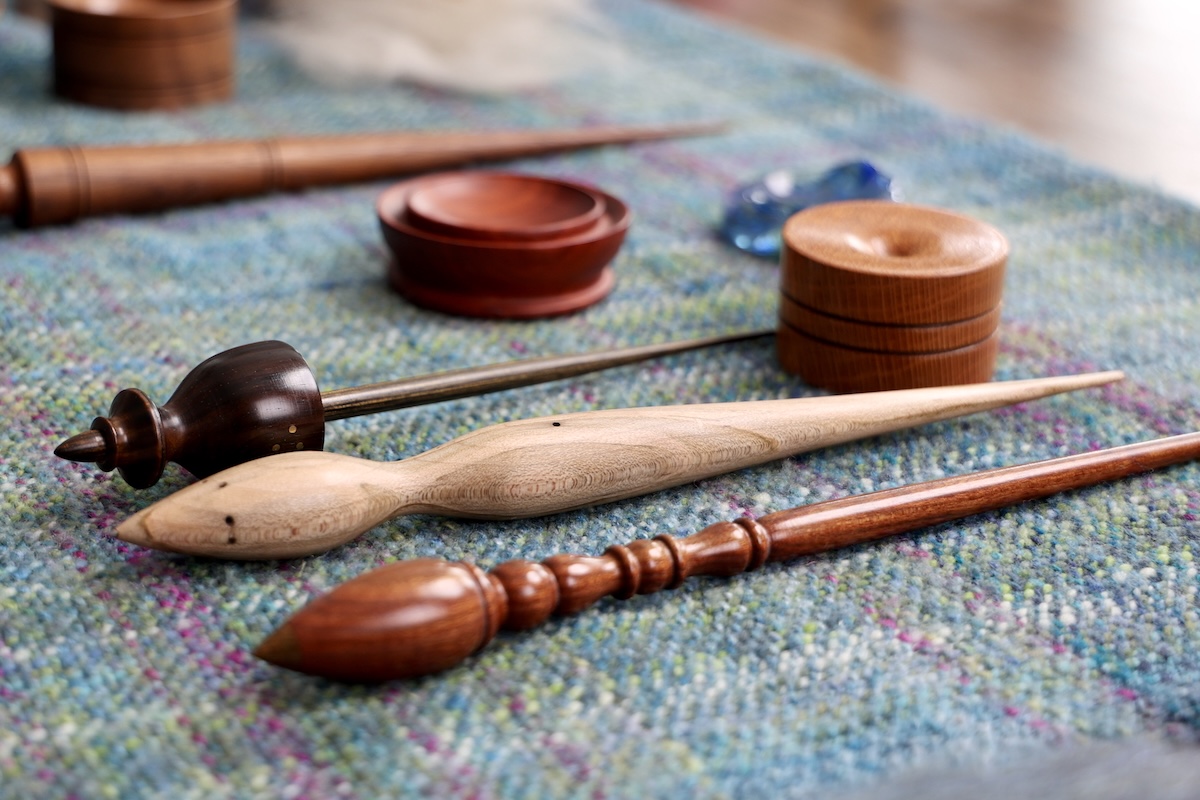
- Separate Whorl Spindles have smooth shafts, often of the same thickness, until the flicking tip. Their whorls are clear and distinct.
- Stick and Whorl Spindles are the earliest yarn-making tools. Evidence of textile production at archeological sites often consists of spindle whorls and bowls. The shafts and spun yarn have long decomposed, but the whorls, made of stone, bone, or hardened clay, remain. In this spinning style, when the cop on the stick gets too large to manage, the whorl is removed and inserted onto another stick for a quick transition and little interruption in spinning.
- Tibetan Spindles have a separate whorl, which can be a flat disc, a cup/bowl shape, or a ball. What makes it a note-worthy style is the shelf provided by the whorl. The shelf provides a solid base to build a cop against.
- Navajo Spindles are a larger supported spindle, set into motion by rolling against the thigh. This style of large spindle is also used in the grasped and tossed spindle technique.
- Takhli Spindles are often small spindles made of brass or other metal popularized for spinning cotton. In recent years, Tahkli is described as a small and fast spindle.
- Modern Hybrid Spindles are often a fusion of styles, especially variations on the Tibetan separate whorl – such as a hand-carved bas-relief on the whorl, or the introduction of new materials such as ball bearings for spindle tips or a Russian-style wand with a blown glass spinning tip/whorl.
Final Thoughts
This concludes the general overview of spindle styles and the various elements that make each unique. If you have the chance, I encourage you to try as many styles of spindles as you can to expand your understanding of and experience with managing a new spindle and putting it through its paces. Let’s see if Stephanie Gaustad’s statement, “One spindle does not do it all, it does what it does again and again”, holds true.
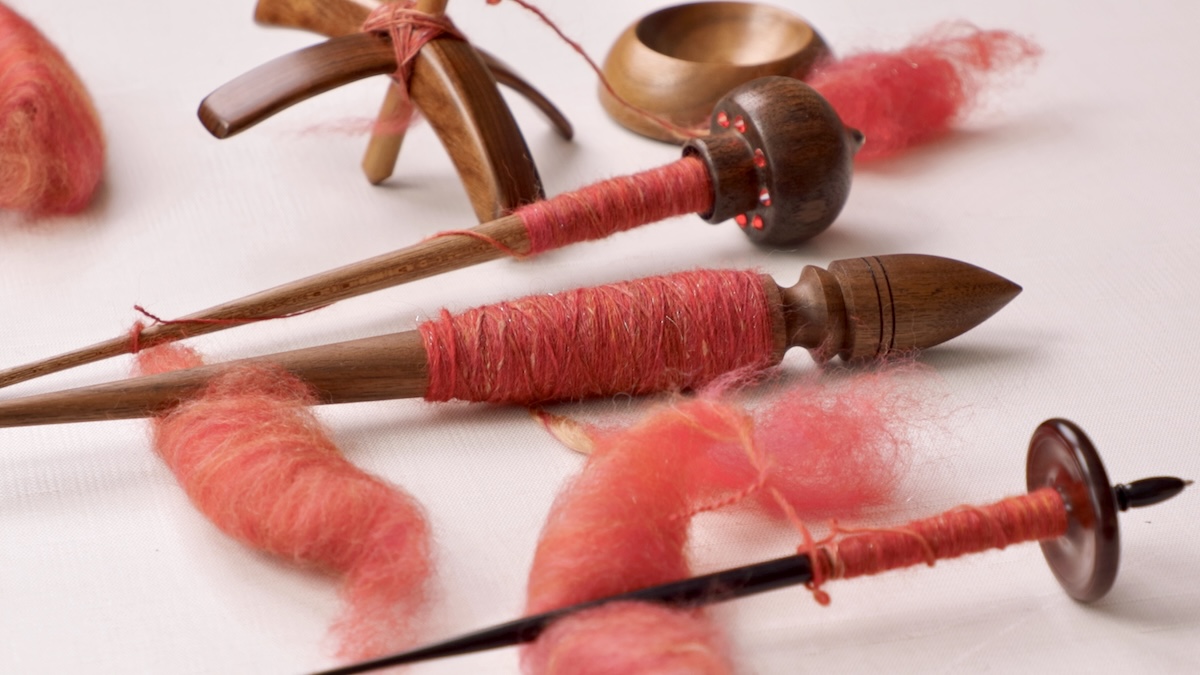
Join Diana Twiss in her course, Next-Level Spindle Spinning, at the School of SweetGeorgia. She explores various spindle styles, delving into the intricacies of each one. You’ll learn how to spin both worsted and woollen yarns, along with tips on plying, luxury fibres, ergonomics, and how to create the yarns you want using just a spindle.
You can also explore more of our spinning articles here, featuring Diana and many others eager to share their knowledge with us!
The post The Taxonomy of Spindles: Spindle Styles & Their Best Uses appeared first on SweetGeorgia Yarns.
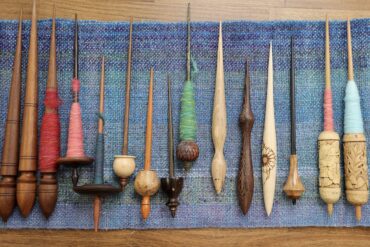
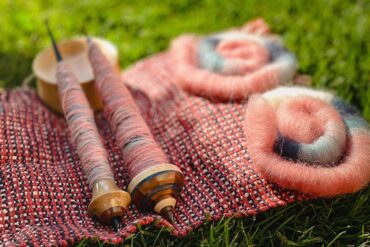

Comments
Post a Comment